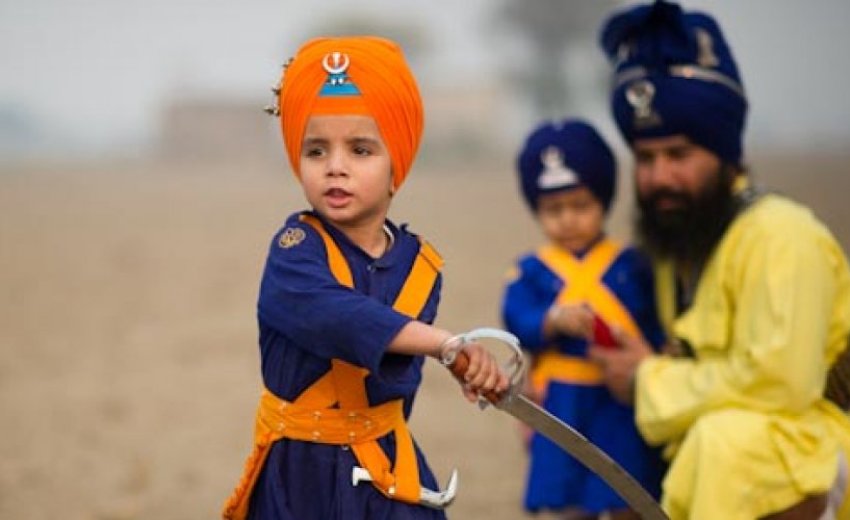Hola Mohalla, also known simply as Hola, is a Sikh festival that lasts for three days and takes place on the second day of the lunar month of Chett. Although it typically follows the Holi festival, which is celebrated by Hindus in the spring, Hola Mohalla and Holi can sometimes be celebrated simultaneously. Sikhs all around the world get together to celebrate the holiday of Hola Mohalla in a huge way.
What does Hola Mohalla entail
Hola Mohalla is an opportunity for Sikhs to demonstrate their martial prowess in mock battles. This was likely done to prevent a bloodier battle against the imperial power and to focus people's energy towards more productive endeavours.
Thousands of Sikhs gather at the several Gurudwaras and forts in Anandpur and march in a procession, as Guru Gobind Singh Ji ordered. There are demonstrations of the Khalsa's martial abilities through Gatka, Neje Baazi (a horseback sport), and wrestling, as well as their literary abilities through Dhadhi Kavishri. The Nihung Fauj, both young and elderly, are on display at their finest.
Throughout the week, the local government and police are only bystanders directing traffic and arranging logistics, demonstrating Sikh sovereignty. An older popular video depicting a Nihung Youth on horseback dismantling barriers aptly captures this mood.
There is no doubting the significance of the traditional arts practised at Hola Mohalla, regardless how much we question the role and appropriateness of modern weaponry such as firearms (including "Chardikala Bad Boy Crossbows") in Sikh places, or the Nihung Baana (outfit). Their traditions and way of life give them both mental and physical power, making them relevant in modern times and likely to remain so in the future.
Martial Arts and other displays of strength
Young Nihungs are trained on how to use available weapons effectively in combat. It may be a Kirpaan (sword), a Soti (stick), or even a flexible PVC pipe; if you know how to use it, you will live and be able to defend yourself and others. They do not question the instrument's historical roots. Astar is something that can be thrown towards a target. If it is portable, it is a Shastar. If either of these is accessible to a Nihung, they are a formidable opponent regardless of their age.
Physical fitness is emphasised. It is essential to have a clean Dumalla (turban) on your head at all times. As essential is caring for your horses. Little children bathing and cleaning their horses while playing with and feeding them is a beautiful sight.
If you have ever ridden a horse on a trail, you know that after an hour the body hurts. It is incredible to watch Nihung teenagers riding their horses with nothing but a big blanket covering the animal's back and their naked feet locked into the stirrups. Their lifestyle discipline at such a young age is not motivated by respect for their elders. It stems from their Gurbani study and practice.
They can recite ancient monologues and poems. They are eager to raise Jakarey (slogans) and announce their existence to their surroundings, like a lion roaring to assert its authority over territory. Their courage may be traced down to their Nihung Jathedar Baba Fateh Singh ji, who performed the same thing in a Mughal court when he was sentenced to death at age six. The Nihungs are proud to be his soldiers - Fateh Singh ke Jathe Singh.
Behind the blue robes and Dumalle of these Nihungs are years of discipline and practise beginning at an early age. Many have unsuccessfully attempted to restrict this source of power, and continue to do so.
Holla Mohalla during the Farmers' Protest in India
Farmers protesting against three disputed farm regulations along Delhi's borders — Singhu, Tikri, and Ghazipur — celebrated Holi and Hola Mohalla in 2021. The protesting farmers asserted that their agitation would continue until the farm laws were repealed and a separate minimum support price law was enacted.
Lok Kala Manch Mandi Mullampur presented the play "Uthan Da Vela" as part of the festival's celebrations.
Abhimanyu Kohar, a farmer leader said, “We celebrated Holi at all the protest sites. Sikhs also celebrated the Hola Mohalla festival. Women from nearby villages of Haryana came to the protest sites and played Holi in a traditional way with a cloth whip.”
Holla Mohalla is indeed a significant festival celebrated by the Sikh community worldwide. The festival has a rich history dating back to the 17th century and has become an essential part of Sikh culture and tradition. It provides an opportunity for Sikhs to connect with their heritage and reinforce their commitment to their faith. Overall, Holla Mohalla is a vibrant and joyous celebration that highlights the values of Sikhism, such as equality, community, and selfless service.

